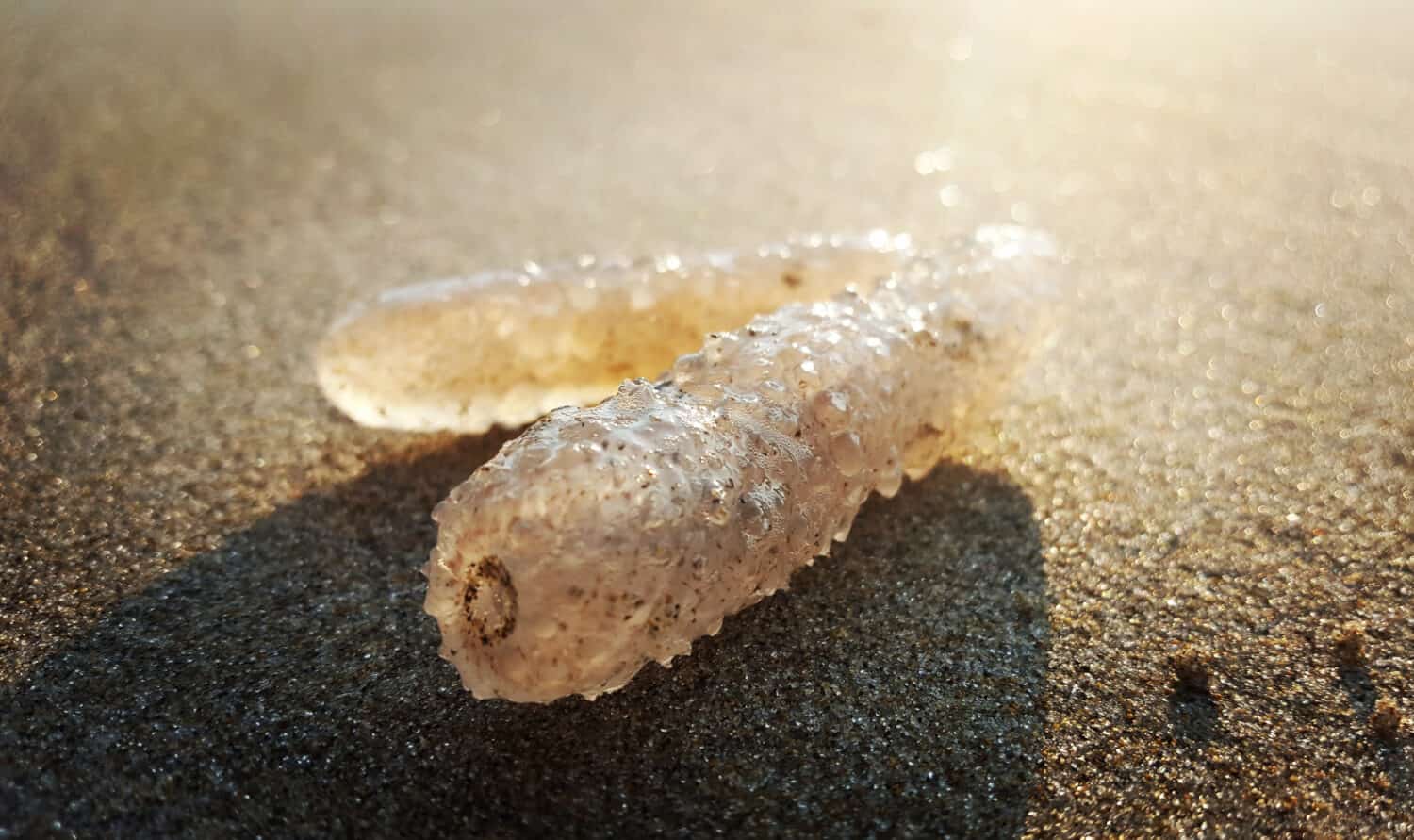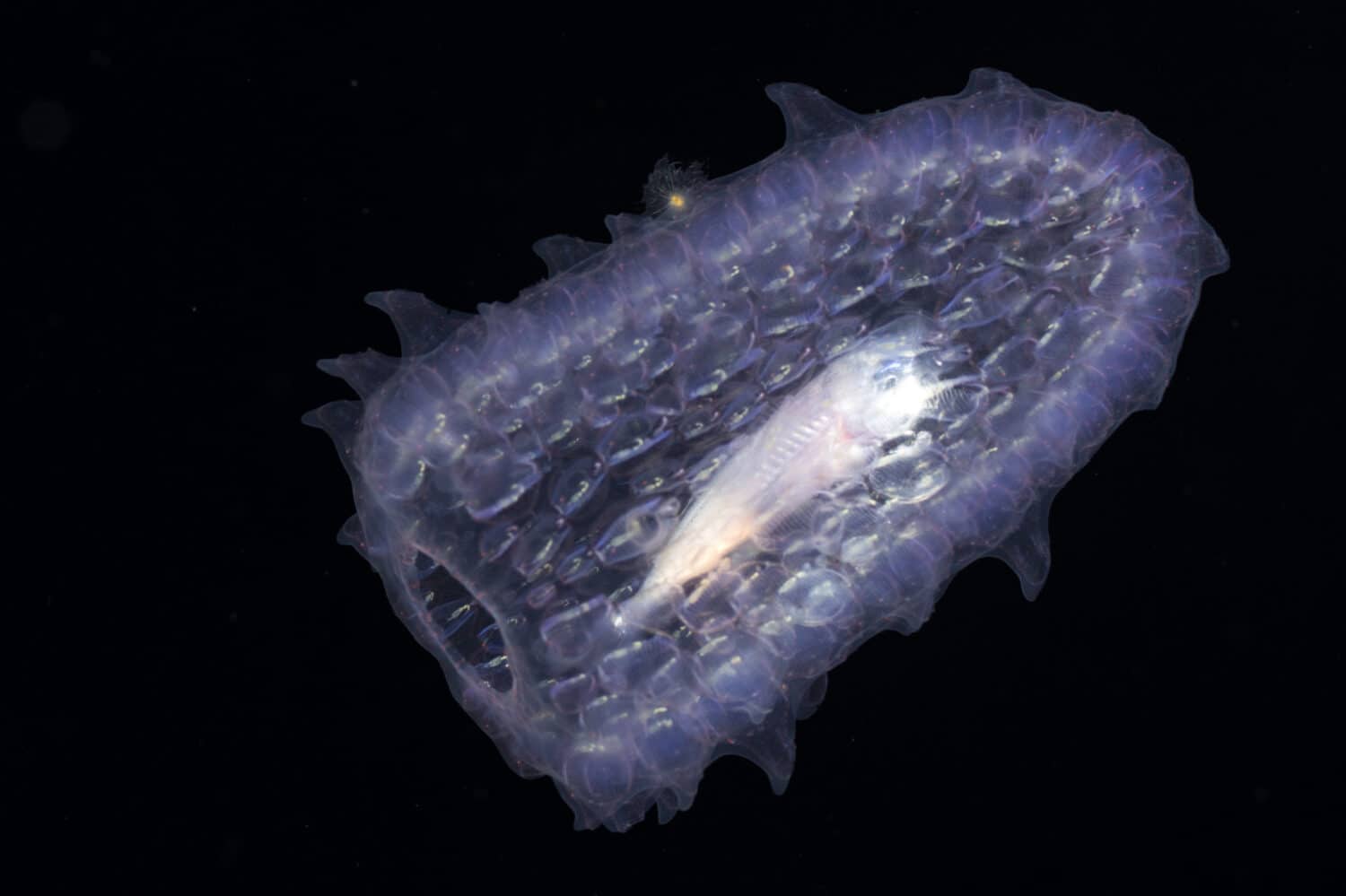Pyrosome
Pyrosomes are composed of hundreds to thousands of tiny zooids!
Advertisement
Pyrosome Scientific Classification
Read our Complete Guide to Classification of Animals.
Pyrosome Conservation Status
Pyrosome Facts
- Group Behavior
- Bloom
- Fun Fact
- Pyrosomes are composed of hundreds to thousands of tiny zooids!
- Other Name(s)
- Sea pickle, sea worm, sea squirt, fire salp, fire body, cockroach of the sea
- Predators
- Fish, sea turtles, sea urchins, crabs, eels, sea birds
Pyrosome Physical Characteristics
- Color
- Yellow
- Blue
- Pink
- Skin Type
- Permeable
- Venomous
- No
- Aggression
- Low
View all of the Pyrosome images!
Pyrosome Summary
Pyrosomes are colonial tunicates comprising hundreds or thousands of zooids. Being pelagic, they float freely with the currents in the open ocean, occasionally influencing their movement via their water filtration system. They occur mainly in tropical waters around the world, though they sometimes also occur in colder regions like the Antarctic. They employ both sexual and asexual reproduction to grow their colonies and regenerate themselves. Because they are a network of many individual organisms, they are delicate and often break up in nets.

Pyrosomes are marine invertebrates composed of hundreds to thousands of zooids.
©dlearyous photography/Shutterstock.com
5 Pyrosome Facts
- Composed of many tiny organisms: Pyrosomes are not single organisms; rather, they comprise hundreds to thousands of tiny organisms called zooids.
- Bioluminescent: These fascinating organisms are bioluminescent, often putting on stunning light displays near the surface.
- Tubular: Pyrosomes resemble gelatinous tubes in the water. Because their sizes vary greatly, swimmers are often able to swim from one end of the tube to the other without harming the organism itself.
- Drift with the current: Pyrosomes are planktonic, which means they mainly drift with the current. However, they are occasionally able to influence their movement by means of their water filtration process.
- Filter-feeders: These tunicates rely on filter-feeding to survive. Using cilia, the individual zooids filter out plankton from the surrounding water, returning the stripped water to the environment.
Pyrosome Scientific Name
Pyrosomes are colonial tunicates belonging to the genus Pyrosoma. Their name comes from the Greek pyro (“fire”) and soma (“body”), which refers to their bioluminescence. Other common names include sea pickles, sea worms, sea squirts, fire salps, fire bodies, and cockroaches of the sea. They further belong to the family Pyrosomatidae, the order Pyrosomida, and the class Thaliacea (pyrosomes, dolioloids, and salps). As tunicates (marine invertebrates), they belong to the subphylum Tunicata within the phylum Chordata.
The World Register of Marine Species (WoRMS) currently recognizes four species within the genus Pyrosoma:
- Pyrosoma aherniosum
- Pyrosoma atlanticum
- Pyrosoma godeauxi
- Pyrosoma ovatum
Notably, scientists have reassigned the giant pyrosome (formerly Pyrosoma spinosum) to the genus Pyrostremma as the giant fire salp (Pyrostremma spinosum). A number of other former Pyrosoma species have undergone a similar process.
Pyrosome Appearance

Pyrosomes are gelatinous, tubular organisms with bumpy outer surfaces.
©Alexander clay detweiler/Shutterstock.com
Pyrosomes are invertebrate chordates with gelatinous, baglike bodies. They are tubular or conical in shape. Rather than being a single organism, they are composed of hundreds or thousands of zooids (multicellular animals that join together to form a larger organism). These zooids work together, often performing different functions to enable the larger organism to function. The outer surface is bumpy, slimy, and tough to the touch.
One of the most striking features of these organisms are their coloration. In sunlight, they are light pink, yellow, or blue. However, at night their bioluminescence manifests in response to colorful flashes of light from other zooids or physical disturbances. These flashes or waves of light can be quite dramatic, particularly at night near the surface of the water.
Pyrosomes range greatly in size. The smallest are well under an inch while the largest grow up to 60 feet in length. Individual zooids are typically only a few millimeters (a fraction of an inch) in size.
Pyrosome Evolution and History
The evolutionary history of pyrosomes is difficult to determine due to the extremely sparse fossil record regarding tunicates. Tunicates have soft, gelatinous bodies that do not fossilize well aside from spicules (hard mineral particles in some tunics). Two of the three classes within the subphylum Tunicata likely derived from a single lineage within the third class, Ascidiacea. It is likely that pyrosomes branched off from within the class Thaliacea with a distant connection to dolioloids and salps. Their colonial nature shows some similarities to the coloniality of ascidians.
Pyrosome Behavior
Pyrosomes spend most of their lives drifting with the current. However, individual zooids influence their movement as they filter water through their bodies using cilia. At night, these organisms sink to depths of up to 2,300 feet, surfacing again during the day. They can migrate as far as 1,345 feet in a single day. They are often found in larger groups called blooms, which form a vital part of their ecosystems.
Pyrosome Habitat

Other species occasionally use pyrosomes for shelter and food.
©Timothy Ewing/Shutterstock.com
Pyrosomes are pelagic and free-floating, preferring the open tropical waters of the Atlantic, Pacific, and Indian Oceans. However, they also occur occasionally in colder waters, including those of the Antarctic Ocean. They typically remain fairly close to the surface, though at night they descend to depths of up to 2,300 feet. It is possible to spot them off the coasts of every continent in the world.
Besides making these habitats their home, these strange organisms contribute to the habitats of other species in the water column. They provide vital biological substrates for other species in need of shelter and food.
Pyrosome Diet, Predators, and Threats
Pyrosomes are omnivorous filter-feeders with an extremely limited diet. However, they themselves provide an important food source for a variety of predators.
What Do Pyrosomes Eat?
These unique organisms survive by filtering out plankton, phytoplankton, and possibly bacteria from the surrounding water. They themselves are planktonic.
What Eats Pyrosomes?
These organisms fall prey to a number of predators, particularly after sudden death when they descend rapidly to the ocean floor. These predators include various species of fish as well as sea turtles, sea urchins, crabs, eels, and sea birds. Observers have also seen some of these animals swimming through the tubes of pyrosomes.
Pyrosome Reproduction and Life Cycle

Pyrosomes use both sexual and asexual reproduction.
©dlearyous photography/Shutterstock.com
Pyrosomes employ both sexual and asexual reproduction. Being hermaphroditic, each zooid produces both eggs and sperm. They are thus able to fertilize their own eggs. These eggs result in embryos which develop into four attached zooids. These zooids then use asexual reproduction to produce genetically identical copies of themselves. Combining sexual and asexual reproduction enables the colony to enlarge and regenerate itself.
Pyrosomes are notoriously delicate, which often confounds scientists attempting to catch them in nets for study. Because they frequently break up on contact, it can be challenging to tell their original size. After they die, their bodies often descend to the ocean floor where they provide vital nourishment for bottom-dwelling creatures.
Pyrosome Population
Because pyrosomes are elusive, scientists do not know how many currently exist in the wild. Additionally, the IUCN does not include them on their Red List of Threatened Species.
Related Animals
View all 192 animals that start with PPyrosome FAQs (Frequently Asked Questions)
Are pyrosomes carnivores, herbivores, or omnivores?
Pyrosomes are omnivorous.
Are pyrosomes fish?
Pyrosomes are not fish.
Where are pyrosomes found?
Pyrosomes inhabit mainly tropical waters worldwide, though they sometimes occur in colder waters.
Can you swim inside a pyrosome?
It is possible to swim inside some of the larger pyrosomes.
Are pyrosomes venomous?
Pyrosomes are not venomous.
Thank you for reading! Have some feedback for us? Contact the AZ Animals editorial team.
Sources
- Florida State University, Available here: https://myweb.fsu.edu/mstukel/researchpyrosomes.html
- Explorersweb, Available here: https://explorersweb.com/natural-wonders-pyrosomes/
- Encyclopedia of Life, Available here: https://eol.org/pages/46585531
- NOAA, Available here: https://www.fisheries.noaa.gov/science-blog/pyrosomes
- World Register of Marine Species, Available here: https://www.marinespecies.org/aphia.php?p=taxdetails&id=137224
- Biodiversity Explorer, Available here: http://www.biodiversityexplorer.info/mm/tunicates/pyrostremma_spinosum.htm#:~:text=Pyrostremma%20spinosum%20(Giant%20fire%20salp)
- ScienceDaily, Available here: https://www.sciencedaily.com/releases/2021/05/210504112631.htm
- Britannica, Available here: https://www.britannica.com/animal/tunicate/Evolution-and-paleontology
- BMC Biology, Available here: https://bmcbiol.biomedcentral.com/articles/10.1186/s12915-018-0499-2

















